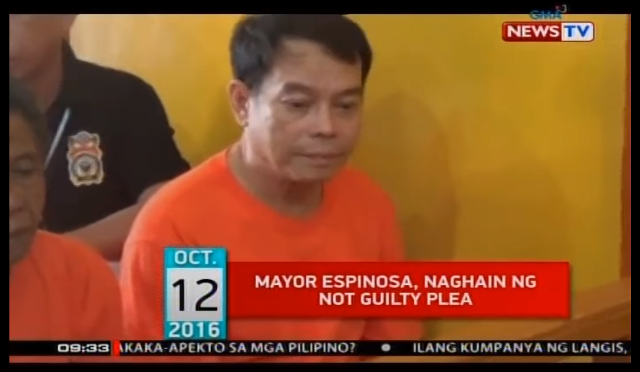On Espinosa Killing: Media’s Investigative Skills Yield Critical Findings

Screengrab from GMA News’ Youtube account.
MANY VICTIMS killed in the bloody war on drugs have raised questions about the conduct of police operations. In its fourth month, more Filipinos are wondering whether the guns, which police say were found near the bodies of the slain in supposedly legitimate police operations, were planted.
Media reports have reflected the public’s skepticism in the controversial killing of Rolando Espinosa Sr., mayor of Albuera town in Leyte province, after a month of imprisonment in the Baybay Sub-Provincial Jail in Leyte.
Operatives of the Philippine National Police Criminal Investigation and Detection Group (PNP-CIDG) Region 8 barged into Espinosa’s cell with a warrant to search for firearms and illegal drugs in the early hours of Nov. 5. According to the CIDG team, Espinosa fired on them. Another detainee, Raul Yap, was also killed in the alleged firefight. There were no police killed or injured.
This week, a report by Nancy Carvajal and Davinci Maru of the Philippine Center for Investigative Journalism (PCIJ) bolstered suspicion of tampering of the crime scene. PCIJ released a set of photos, according to their source, which were taken immediately after the shooting and before the Scene of the Crime Operatives (SOCO) team arrived. PCIJ’s photos showed Espinosa’s “bloodied body lying flat on his back with his eyes half-open, and both of his hands empty.” The photos that the CIDG released show the mayor’s body “slumped sideways with his right knee slightly up, and with his right hand appeared to be holding a gun.”
In the Senate hearing on the Espinosa killing on Nov. 10, PNP Superintendent Jose Melvin Tamaca disputed the photos that PCIJ obtained, saying that the presence of chalk marks in these photos indicate that the scene had already been processed by the SOCO. This point however does not change the plausibility that the crime scene had been tampered with remains.
Jay Sabale of GMA-7 also captured an exclusive video in which a CIDG officer was seen serving a warrant to the already dead Espinosa. The footage also shows a member of the local media recording the CIDG officer reading the warrant using his mobile phone. During the same Senate probe, Police Chief Inspector Leo Laraga of PNP-CIDG Region 8 countered that the warrant was read not to Espinosa but to the jail warden and the witness, but this does not invalidate the point that he was reading it after the killing.
The PCIJ and GMA-7 reports move the story forward and sustain the doubts about the credibility of police claims.
Killed Inside His Cell
Espinosa was one of the mayors that President Duterte named in his “narco-list.” He was the second mayor in the list to be killed, following the Oct. 28 death of Datu Saudi Ampatuan town mayor Samsudin Dimaukom in what police said was a shooting encounter during a vehicle inspection. Former PNP chief and now senator Panfilo Lacson, who also heads the senate committee on public order and dangerous drugs, described the incident as a “clear case of extrajudicial killing” and called it a badly-written script.
Prior to the Nov. 10 Senate probe of the Espinosa killing, the press has been doing an adequate job following up on the incident, posing questions that expressed doubt and speculation surrounding the operation. The media have pursued a more critical line of questioning, noting irregularities such as the necessity to conduct the search at 4 in the morning and to serve a warrant to somebody who was already detained in a government-run jail facility.
Suspicious Circumstances
The lack of coordination between the CIDG and the jail officers was also questioned. Jail guards who refused to allow the CIDG personnel inside were disarmed by the latter. Bolt cutters were used to enter the prison cell.
The CIDG’s claim that a “shootout” ensued also contradicts eyewitness testimony. Reports cited an inmate who said that Espinosa and Yap were fired upon by the CIDG. This detainee also said that Espinosa even begged the CIDG not to plant evidence (firearm and drugs) in his cell. Reports also noted that the closed-circuit television (CCTV) footage of the incident was missing.
Given the dubious circumstances surrounding the death of Espinosa and Yap, the Senate promptly reopened the investigation on extrajudicial killings. As the fight against drugs continues, the state should take responsibility for the security of those who are already under the custody of law. It should also hold accountable law enforcers who violated protocol, police procedures and the country’s laws during the operation.
Leave a Reply